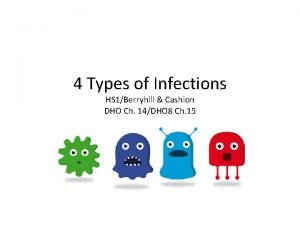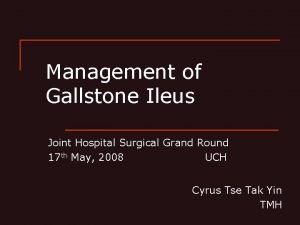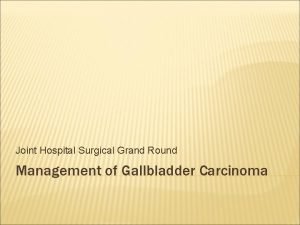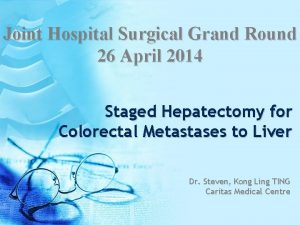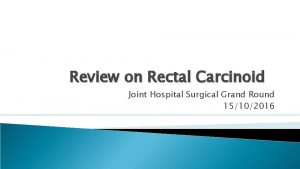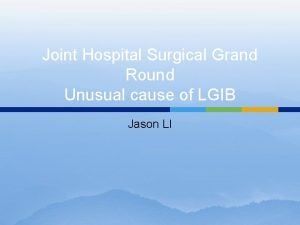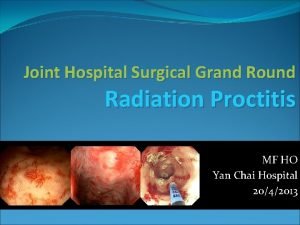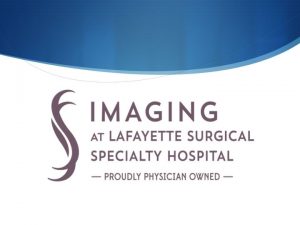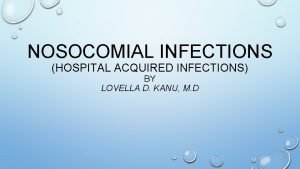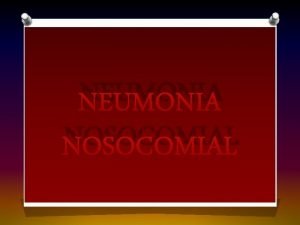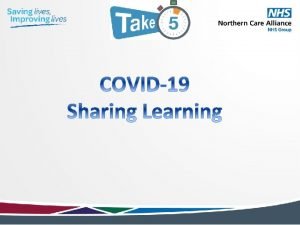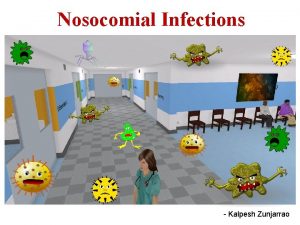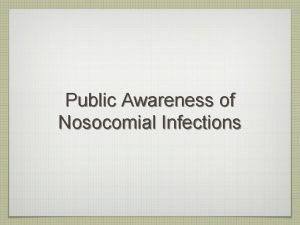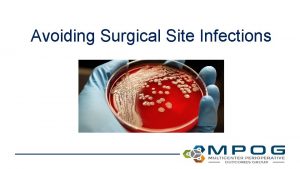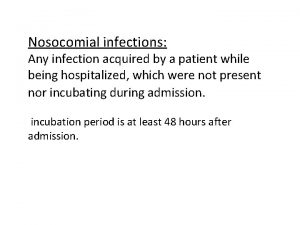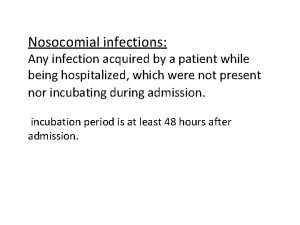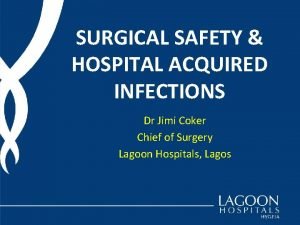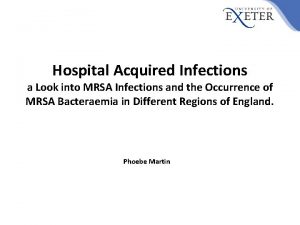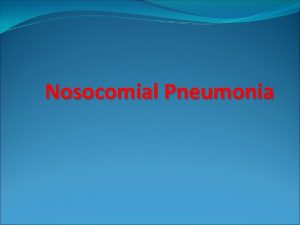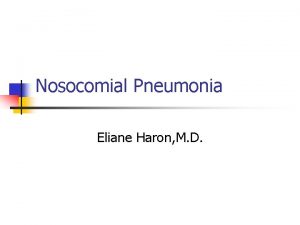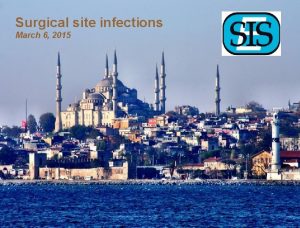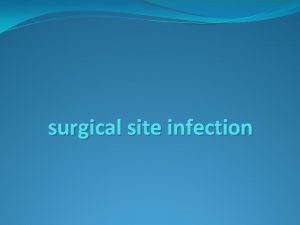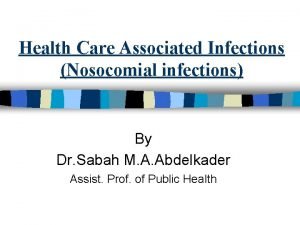Nosocomial Hospital Acquired Infections Surgical Site Infections An


















- Slides: 18

Nosocomial ‘Hospital Acquired’ Infections Surgical Site Infections An International Approach Jeanette Carlson, Hai Nguyen and Eduardo Rotenberg University of Victoria, Canada Copyright: Helen Stevens 2004

Project Purpose § University of Victoria – Healthcare Messaging Standards course (HINF 430) ü 4 th year undergraduate course, required component of Health Information Sciences program § HINF 430 Project requirements: üContribute to the Intellectual Property of an international Standards Development Organization üProject proposal, presentation, and final report Copyright: Helen Stevens 2004

Project Team Members § Both Jeannette and Eduardo have completed co-op work terms as part of the University of Victoria Heath Information Sciences program. Hai will be completing his work terms in the USA in 2005. § Jeannette Carlson ü New Brunswick Department of Health and Wellness, Medicare/Prescription Drug Program health information management officer responsible for retrieving, processing and presenting prescription drug data. ü UK National Health Service (NHS), National Patient Safety Agency (NPSA). Implementation analyst responsible for assisting the manager in an effective rollout of the National Reporting and Learning System. This system was responsible for tracking all adverse patient safety incidents and near misses occurring in the NHS in England, Scotland Northern Ireland Wales. § Eduardo Rotenberg ü BC Children’s and Women’s Health Centre. Evaluated ISO 17799 (security) standard into the CHIPP Project, a project in which health information was to be electronically shared between facilities specialized in paediatric oncology. ü BC Centre for Disease Control. Collected, summarized and Copyright: Helen Stevens 2004

Deliverables & Stakeholders § Deliverables ü Using international perspectives, design a storyboard representing a nosocomial case ü RMIM Diagram modeling the storyboard including a comprehensive diagram walkthrough • Using HL 7 RMIM Designer • Following HL 7 V 3 RIM and modeling methodology § Project Stakeholders: ü ü Rob Borotkanics – Project mentor Anita Benson – Project primary contact Ali Rashidee – Co-chair Patient Safety SIG Alan Flett – National Patient Safety Agency, UK • HL 7 Patient Safety SIG member with Clive Flashman ü Pamela Kibsey – VIHA Microbiologist ü Max Walker – Vocabulary Technical Committee member, HL 7 Australia ü Dr. Richard Stanwick – Vancouver Island Chief Medical Health Officer Copyright: Helen Stevens 2004

Project Outcomes § Identified and provided additional documentation about nosocomial infections to committee members to assist in current work on dialysis incidents § Developed base line storyboard and RIM compliant model for nosocomial infections Copyright: Helen Stevens 2004

Storyboard: Presentation § Mrs. Brown, a 56 year old women has been a marathon runner since she was 16. During the past few months she has discovered a slight clicking in her left knee as she goes down staircases, or bends her knee past 30 degrees. § One day while simply standing up, Mrs. Brown’s knee locked in a 90 degree position. Mrs. Brown could not move her knee from this position. § Mrs. Brown was taken to the County Down Hospital where she was admitted to the emergency department. Upon being seen by Dr. Pink, it was discovered that Mrs. Brown had a partially torn cartilage in her knee that would have to have the tear removed. § Dr. Pink explained this surgery would be done by an endoscopic surgeon Dr. Mauve who would do a simple keyhole procedure in order to repair her knee. He explained that this surgery was very simple and had minimal risk associated with it. It would involved 4 incisions around her knee only about a centimetre wide to get the scopes thorough. § The expected recovery would be overnight at a maximum but in all likelihood Mrs. Brown could go home the same day as the surgery on a set of crutches. Copyright: Helen Stevens 2004

Storyboard: Incident § After spending the night in the hospital, Mrs. Brown was admitted to surgery for 8 o’clock the following morning. § Upon completion of the surgery, Mrs. Brown was taken back into her ward for recovery and released later the same day. During the mandatory monitoring period of Mrs. Brown’s knee, she started complaining to Dr. Mauve that her knee was in pain. § Three days later Mrs. Brown was readmitted to the hospital after Dr. Mauve observed redness and swelling in her knee around the surgical site. § A sample of swelling fluid was taken from Mrs. Brown’s knee and sent to the laboratory for investigation. In the mean time, Mrs. Brown was given some pain killers to ease her symptoms. Copyright: Helen Stevens 2004

Storyboard: Investigation § After several other complaints of infections in people who had undergone endoscopic surgery at the County Down Hospital, a nosocomial infection investigation was launched. § It was discovered the bacteria causing the swelling was one which could be found upon an improperly cleaned endoscope. § The swelling fluid was examined along with the endoscope used in the procedure. It was found that the endoscope had been used in several surgeries without being replaced as it should be. Instead the scope was being cleaned. § In accordance with County Down Hospitals reporting policies, Dr. Mauve was required to file an adverse incident report to the risk management department of the County Down Hospital. She was to include information about the patient, herself as the surgeon and about the Copyright: Helen Stevens 2004

Storyboard Evaluation § Storyboard uses a typical incident to demonstrate a possible occurrence of a nosocomial infection. § Storyboard outstanding issues: üDoes not use HL 7 -defined names for entities (hospital, patient, doctors etc. ) • Helen to provide worksheet to committee to modify storyboard to conform to HL 7 publishing guidelines. üDoes not explicitly identify messaging instances within the story Copyright: Helen Stevens 2004

RMIM Diagram Copyright: Helen Stevens 2004

Walkthrough: Act Classes § Nosocomial. Infection. Investigation ü Entry point for this model. This act is performing an investigation on all of the other acts. This act must be performed on all presenting nosocomial infections. § Surgical. Procedure ü Models the actual procedure performed on the patient in which the infection was acquired. Contains pertinent encounter information as to when and why the patient was admitted to the hospital. In other models this may be another way of acquiring the initial infection. § Readmission ü Models the event of the patient being readmitted to the hospital after acquiring symptoms of possible infections. This point starts off the identification of the infection and infecting pathogen to discover that a nosocomial infection has actually occurred. § Pathogen. Observation ü This is the observation of the infecting pathogen. It describes the processes required to establish what the pathogen is and Copyright: Helen Stevens 2004 where/how it may have been contracted.

Nosocomial. Infection. Investigation § § § Act models the information gathered during a nosocomial investigation as well as the act of carrying out the investigation itself. Contains the entry point of the RMIM. When a nosocomial infection is suspected, the process will be entered through the nosocomial infection investigation. Incident. Report ü This act represents the report to be put together based on the nosocomial investigation and the events preceding it. § Surgical. Procedure ü The act of the surgical procedure is stated here just for information pertaining to the incident report. § Diagnosis ü diagnosis is an observation of the patient in which it was classified a nosocomial was present. § Evidence. Of. Infection ü observed evidence of infection which was the reason of classifying as a nosocomial infection case. § Spontaneous. Dihisces. Or. Opened ü observation of a spontaneous dihisces or opened wound that lead to classification of the infection as nosocomial. § Drianage. From. Incision ü observation of drainage from the surgical incision that lead to the classification of the infection as nosocomial. ü Act Relationship Copyright: Helen Stevens 2004 • subject. Of - the subject of relationship, is intended to model the presence of one of the

Pathogen. Observation § This act represents the start of the entire process to discover the specific pathogen (and perhaps cause) of the infection within the patient. It also monitors any additional secondary blood infections that might have been caused from the initial surgical site infection. § Culture ü The culture is the actual viral culture taken from the suspected infecting material (in this example the endoscope). Because viruses are antibiotic resistant, they must be cultured directly from the material. § Check ü This act is the act of checking for a secondary bloodstream infection. § Antimicrobial. Susceptibility ü In order to deduce what bacteria caused the infection, an antimicrobial susceptibility test is performed on the bacteria to see which antibiotics the bacteria responds too. Because viruses are antibiotic resistant, they must be cultured directly from the material. § Lab. Test. Results ü This act is an act in fulfillment of the ordered test. It produces the results of the swelling fluid taken from the patient. § Test. Order ü The test ordered due to the patient’s readmission into the hospital. Usually ordered by attending physician. Copyright: Helen Stevens 2004

Readmission § This act represents the act of readmitting the patient for treatment and investigation of the symptoms of infection they are currently showing. § Substance. Administration. Event üAntibiotics must be administered in order to control the presenting symptoms (pain and swelling). The test order will not be completed at this point so this is not a cure, it is just a temporary measure to suppress the current symptoms. Copyright: Helen Stevens 2004

Surgical. Procedure § This is the act of the patient’s initial surgery on the knee. § Encounter ü This act is the patient’s original surgical encounter. This is the encounter in which the suspected infection was obtained. § Monitor. Surgical. Site ü After each and every surgery, a monitoring period is required to take place. This act represents this period and in the example triggers the observed problem and eventual readmission of the patient. § Observed. Problem ü The observed problem is that of the swelling of the Copyright: Helen Stevens 2004 knee and the patients complaint of pain. This problem

RMIM Evaluation § Diagram is a representation of the information necessary to support the storyboard § Diagram and walkthrough follow HL 7 V 3 guidelines § RMIM successfully validates against RIM § RMIM outstanding issues: üRMIM is a starting point for the committee – it is not ballot ready. üVocabulary requirements have not been resolved Copyright: Helen Stevens 2004

Conclusions § The U-Vic students submit this work to the Patient Safety SIG for their consideration. üIt is hoped that this work is useful in helping the SIG accelerate development of HL 7 standards in this area critical to patient safety § The work submitted must be considered in the context of being work completed by under-graduate students and although comprehensive, it requires further development by the SIG and validation by industry experts. Copyright: Helen Stevens 2004

Thank you and Questions? Copyright: Helen Stevens 2004
 Salmonella life cycle
Salmonella life cycle Beth has a nosocomial infection. how did she get it?
Beth has a nosocomial infection. how did she get it? Wellspan inet
Wellspan inet Tmh
Tmh Joint hospital surgical grand round
Joint hospital surgical grand round Joint hospital surgical grand round
Joint hospital surgical grand round Joint hospital surgical grand round
Joint hospital surgical grand round Joint hospital surgical grand round
Joint hospital surgical grand round Joint hospital surgical grand round
Joint hospital surgical grand round Conclusion of oral medication
Conclusion of oral medication Broad-based disc bulge
Broad-based disc bulge Surgical site infection bundle checklist
Surgical site infection bundle checklist Hot site cold site warm site disaster recovery
Hot site cold site warm site disaster recovery Number of pharmacist required for 250 beds
Number of pharmacist required for 250 beds Opportunistic infections
Opportunistic infections Can methotrexate cause yeast infections
Can methotrexate cause yeast infections Opportunistic infections
Opportunistic infections A bacterial std that usually affects mucous membranes
A bacterial std that usually affects mucous membranes Understanding the mirai botnet
Understanding the mirai botnet

